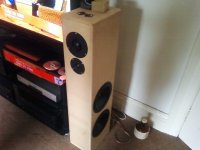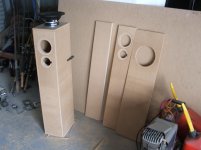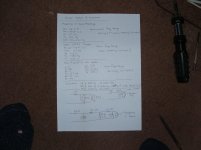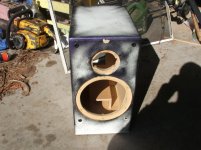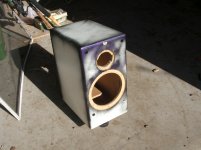Just toying with the idea of a transmission line setup using the vifa p22wp-01
in a three-way set up, but just not sure exactly where to start.
SPECS; 4 ohm nom
RE. 3.0
fs 30 Hz
qms 2.2
qes .31
qts .272
sd 235 cm2
vas 77
90 db sens
bl 10.2
I'm led to believe the specs make it a fairly good candidate for a tl, although i'm not sure what makes it so.......... I have used them in BR with good results, however i feel that these drivers have more to give than i can extract from them in a bass reflex design. I would love to make this project fly but i'm not sure how to work out taper ratios, driver placement and other associated hoo haa for a given driver. If i could get them going without destroying an entire rain forrest, that would be a big bonus
 . If you have trudged down this road b4 what advice could you give (Other than, GIVE UP!!!!)
. If you have trudged down this road b4 what advice could you give (Other than, GIVE UP!!!!) !
!
in a three-way set up, but just not sure exactly where to start.
SPECS; 4 ohm nom
RE. 3.0
fs 30 Hz
qms 2.2
qes .31
qts .272
sd 235 cm2
vas 77
90 db sens
bl 10.2
I'm led to believe the specs make it a fairly good candidate for a tl, although i'm not sure what makes it so.......... I have used them in BR with good results, however i feel that these drivers have more to give than i can extract from them in a bass reflex design. I would love to make this project fly but i'm not sure how to work out taper ratios, driver placement and other associated hoo haa for a given driver. If i could get them going without destroying an entire rain forrest, that would be a big bonus

 . If you have trudged down this road b4 what advice could you give (Other than, GIVE UP!!!!)
. If you have trudged down this road b4 what advice could you give (Other than, GIVE UP!!!!) !
!Well, MJK's website is required reading for all things TL and you can accurately model the results in his software. There's also a yahoo! groups forum to help you along the way if need be.
I don't agree that its published specs make it a prime candidate for TL loading if you want max flat bass extension unless driven with a high output impedance due to its low Qts. For this you want a large BLH. For the theoretically highest SQ in a box alignment, then a max flat impedance TL is it, but we're talking about a small, heavily stuffed TL with a ~108.5 Hz Fp, so not even good for mid-bass.
http://www.quarter-wave.com/
http://tech.groups.yahoo.com/group/quarter-wave/
GM
I don't agree that its published specs make it a prime candidate for TL loading if you want max flat bass extension unless driven with a high output impedance due to its low Qts. For this you want a large BLH. For the theoretically highest SQ in a box alignment, then a max flat impedance TL is it, but we're talking about a small, heavily stuffed TL with a ~108.5 Hz Fp, so not even good for mid-bass.
http://www.quarter-wave.com/
http://tech.groups.yahoo.com/group/quarter-wave/
GM
Thanx GM,
Your feedback has been very useful, this driver then is more bass reflex suitable then? They are currently being used in a BR setup, 23 litres with a port 80x50x190 mm rectangular and flared. Bass is strong and clean except for an audible dip around 80 hz (Tested with my tone disc). I don't have measuring equipment but the dip must be at least 4 db. The boxes are made from 25 mm mdf, the drivers are resessed flush, with a half inch radius round off internal around the driver. I have tried internal damping, figuring it could be caused by standing waves, but to no avail. I suspected a TL could be the answer but am obviously off coarse again. I am certain its not a room response problem, as it happens in every room. Where did I go wrong? What would you suggest for a flat response with this driver? I tried a bigger box (30L) but they went VERY shy. Thanx again, Mick.
Your feedback has been very useful, this driver then is more bass reflex suitable then? They are currently being used in a BR setup, 23 litres with a port 80x50x190 mm rectangular and flared. Bass is strong and clean except for an audible dip around 80 hz (Tested with my tone disc). I don't have measuring equipment but the dip must be at least 4 db. The boxes are made from 25 mm mdf, the drivers are resessed flush, with a half inch radius round off internal around the driver. I have tried internal damping, figuring it could be caused by standing waves, but to no avail. I suspected a TL could be the answer but am obviously off coarse again. I am certain its not a room response problem, as it happens in every room. Where did I go wrong? What would you suggest for a flat response with this driver? I tried a bigger box (30L) but they went VERY shy. Thanx again, Mick.
shy bass
This is my latest project, and its a dismal failure. Such a failure in fact that I shall totally (almost) clean sheat it Hence the reason for looking at a transmission line enclosure.
Hence the reason for looking at a transmission line enclosure.
The midrange to top end is as sweat as anything i've heard, to be honest, open almost to a fault, tons of head room, astounding detail, yet never hisses an ess, listening to Dianna krall, Donald Fagen, and the like, (except on overly bright recordings, ie, some modern pop and the like). Imaging in this range is dead bang pinpoint. Sound stage is nice and wide, and sounds like vocals are coming from dead centre and five feet back. It is therefore this part that I really need to keep intact.
But then the bass is just plain crap, as sweat as the rest of it is , the bass is a polar opposite to be frank.
I guess the side firing bass is a good concept, if you hold bass directly responsible for the global financial crisis........... WOW what a flop!
In a vain attempt to save face (and bass), I plugged the bass port completely, (the bass port is actually external) and added another bass driver in parallel, (I did this because the box was 30 ltrs and winisd tells me a sealed box for 1 bass driver is 13 ltrs), and halved the value of the 1st order slope on the xo. That helped a little but is far from a cure. Clean sheet me thinks.
The best bass i've had from them so far is the 23 ltr box I mentioned in an earlier post, Except for that annoying dip at around 80 hz that I could not seem to cure, which gave them a 'lack of bass attack' sound, although the rest of it (bass) sounded tight, clean, and powerful with good extension.
Could the box LxWxH ratios have caused this? Seems like a likely suspect as far as I can tell.
 Figure the 23 ltr box, rear vented, but all drivers on the front baffle might be the go. That is in keeping with the KISS principle.
Figure the 23 ltr box, rear vented, but all drivers on the front baffle might be the go. That is in keeping with the KISS principle.
As you can see from the photos, I have experience, but i'm far from an expert. Any Thoughts, always welcome.
 Mick.
Mick.
This is my latest project, and its a dismal failure. Such a failure in fact that I shall totally (almost) clean sheat it
 Hence the reason for looking at a transmission line enclosure.
Hence the reason for looking at a transmission line enclosure.The midrange to top end is as sweat as anything i've heard, to be honest, open almost to a fault, tons of head room, astounding detail, yet never hisses an ess, listening to Dianna krall, Donald Fagen, and the like, (except on overly bright recordings, ie, some modern pop and the like). Imaging in this range is dead bang pinpoint. Sound stage is nice and wide, and sounds like vocals are coming from dead centre and five feet back. It is therefore this part that I really need to keep intact.

But then the bass is just plain crap, as sweat as the rest of it is , the bass is a polar opposite to be frank.
I guess the side firing bass is a good concept, if you hold bass directly responsible for the global financial crisis........... WOW what a flop!
In a vain attempt to save face (and bass), I plugged the bass port completely, (the bass port is actually external) and added another bass driver in parallel, (I did this because the box was 30 ltrs and winisd tells me a sealed box for 1 bass driver is 13 ltrs), and halved the value of the 1st order slope on the xo. That helped a little but is far from a cure. Clean sheet me thinks.
The best bass i've had from them so far is the 23 ltr box I mentioned in an earlier post, Except for that annoying dip at around 80 hz that I could not seem to cure, which gave them a 'lack of bass attack' sound, although the rest of it (bass) sounded tight, clean, and powerful with good extension.
Could the box LxWxH ratios have caused this? Seems like a likely suspect as far as I can tell.
 Figure the 23 ltr box, rear vented, but all drivers on the front baffle might be the go. That is in keeping with the KISS principle.
Figure the 23 ltr box, rear vented, but all drivers on the front baffle might be the go. That is in keeping with the KISS principle. As you can see from the photos, I have experience, but i'm far from an expert. Any Thoughts, always welcome.
 Mick.
Mick.Attachments
At a glance, it looks like the port frequency in the 23L enclosure is very low, like ~25Hz. Am I correct?
Maybe I misconstrued your port dimensions. 80mm x 50mm rectangle opening x 190mm long?
I'll recalculate, maybe it's too late in the evening for math...
I'll recalculate, maybe it's too late in the evening for math...
😕 I calculate that 5x8 = 40 or the same as a 7.15 cm tube (diam). A quick glance in Weems book chart seems to suggest around 45 hz for that length. Do rectangles and tubes behave differently? or did I just plain get it wrong? If so, what is the right method?
Thanx again, Mick.
Thanx again, Mick.
My mistake. It's indeed too late for math, it took me 20 minutes to notice I was insistent on considering the radius as a diameter and halving it again while converting to inches... duh.
As long as the rectangle is not too skinny, the equivalent diameter is fine.
For future reference, here's the formula:
Lv=((1.463*10^7*Rv^2)/(Fb^2*Vb))-1.463*Rv
Lv = vent length in inches
Rv = vent radius in inches
Vb = box volume in cubic inches
at 45 Hz, that's about 8.6 in, 21.8cm... Close enough for estimates.
Sorry for the confusion!
As long as the rectangle is not too skinny, the equivalent diameter is fine.
For future reference, here's the formula:
Lv=((1.463*10^7*Rv^2)/(Fb^2*Vb))-1.463*Rv
Lv = vent length in inches
Rv = vent radius in inches
Vb = box volume in cubic inches
at 45 Hz, that's about 8.6 in, 21.8cm... Close enough for estimates.
Sorry for the confusion!
Geez Tim, ya had me worried for a while.......but I really do have to learn this algebra thingy sometime real soon, (been just relieing on online calcs and the like).
Still not getting this tranmission line thing though, I've gotta confess. My 'Great sound stereo speaker manual' by David Weems, suggests that a low Q driver is generally a good
TL choice, GM certainly disagrees. Does this depend on the type of TL in question?
Alternatively is Weems book considered 'old hat' now?
One thing is certain, it is still a hotly contested theory from where I stand!
Thanx again for your input.
Still not getting this tranmission line thing though, I've gotta confess. My 'Great sound stereo speaker manual' by David Weems, suggests that a low Q driver is generally a good
TL choice, GM certainly disagrees. Does this depend on the type of TL in question?
Alternatively is Weems book considered 'old hat' now?
One thing is certain, it is still a hotly contested theory from where I stand!
Thanx again for your input.
That's a nice looking bit of cab work there Mick... Did you use any stuffing in your box.. Have any luck with different types?
Is that the Jaycar mid dome or?
Keep us up to date with your TL's mate.
Dean
Is that the Jaycar mid dome or?
Keep us up to date with your TL's mate.
Dean
Dean again....
Does the bass dip at 80hz then rise again lower down to then mechanically roll off. Or at 80 it just goes south in both senses?
Are there any impedance peaks in that area that you might Zobel/LCR it.
Or maybe a baffle step circuit is an option.
The few quid/hour it will cost will be heaps easier than building a TL that is generally only good for another 5/10Hz extension.
Then whether it works or not build the TL 😀 And post some pics
Does the bass dip at 80hz then rise again lower down to then mechanically roll off. Or at 80 it just goes south in both senses?
Are there any impedance peaks in that area that you might Zobel/LCR it.
Or maybe a baffle step circuit is an option.
The few quid/hour it will cost will be heaps easier than building a TL that is generally only good for another 5/10Hz extension.
Then whether it works or not build the TL 😀 And post some pics
Attachments
Still not getting this tranmission line thing though, I've gotta confess. My 'Great sound stereo speaker manual' by David Weems, suggests that a low Q driver is generally a good
TL choice, GM certainly disagrees. Does this depend on the type of TL in question?
Alternatively is Weems book considered 'old hat' now?
One thing is certain, it is still a hotly contested theory from where I stand!
Thanx again for your input.
That's not what I said! I qualified it WRT what sort of performance you're wanting from this driver's specs. That said, short of an 'ideal' BLH (huge) some form of TL is the best box loading option overall once one moves away from an OB.
There's really nothing of interest to debate, you and the public at large are just viewing from a position of ignorance. The basic physics was already well understood by the time the pioneers of audio began developing sound reproduction systems and the intense research done by Bell Labs/WE, Siemens and others early on pretty much filled in any missing info and why there's been virtually no substantive breakthroughs since then. As the inventor Tom Danley once lamented, the ancients keep 'stealing' his inventions and a certain manufacturer has become an economic tour-de-force by re-inventing expired patents. What was once old is yet new again.
More specifically to DIY speaker design/building books, one thing I learned early on is that as a general rule, folks who make the effort to educate themselves to a higher than average level and particularly those who want to/are trying to make a living with it aren't going to share much of it free gratis except by way of example and even then may misdirect to some extent by offering an acceptable generic alternate design routine that performs well enough, just not optimum except possibly over a narrow range of design variables. Sad to say, some have even flat out lied to protect their knowledge as much as practical and because of who they are have historically done a good job of keeping the casual DIYer 'in the dark'.
Then there's the experts that just plain get it wrong for whatever reason, but it becomes design 'gospel' anyway among the less educated on the subject until someone comes along with such a preponderance of evidence to prove it wrong that only a fool would not accept it.
Those with a vested interest in keeping the general populance 'in the dark' will typically do their best to discredit it or at least minimize its impact on the status quo, sometimes to the point of making a fool of themselves, but such is the way of human nature, especially when one's ego holds sway over common sense.
Anyway, WRT your specific app, I'm confused now. You say it's a 23 L BR, then 30 L, show a tower speaker that's not necessarily a BR, etc., so your ~80 Hz dip may be either box and/or driver-ceiling mode generated, ergo will be the same for every room if they have a ~8 ft ceiling, but will need complete box design/room details to see what's what.
Bottom line, if you want to make bass with a low Qts driver you either have to use a very large cab tuned low and/or trade some driver/cab efficiency for tonal balance over a wider BW by incorporating some BSC and/or drive it with a high output impedance.
From this we see that DW isn't wrong per se as some form of TL IS the optimum for low Qts drivers since they have the most cab design/tuning flexibility, he just doesn't give you enough pieces of the 'puzzle' to make it an optimum choice unless the info is 'buried' elsewhere in the book, which I'm guessing it's not, or at least not obvious enough for the casual DIYer to optimally piece together.
GM
That's not what I said! I qualified it WRT what sort of performance you're wanting from this driver's specs. That said, short of an 'ideal' BLH (huge) some form of TL is the best box loading option overall once one moves away from an OB.
There's really nothing of interest to debate, you and the public at large are just viewing from a position of ignorance. The basic physics was already well understood by the time the pioneers of audio began developing sound reproduction systems and the intense research done by Bell Labs/WE, Siemens and others early on pretty much filled in any missing info and why there's been virtually no substantive breakthroughs since then. As the inventor Tom Danley once lamented, the ancients keep 'stealing' his inventions and a certain manufacturer has become an economic tour-de-force by re-inventing expired patents. What was once old is yet new again.
More specifically to DIY speaker design/building books, one thing I learned early on is that as a general rule, folks who make the effort to educate themselves to a higher than average level and particularly those who want to/are trying to make a living with it aren't going to share much of it free gratis except by way of example and even then may misdirect to some extent by offering an acceptable generic alternate design routine that performs well enough, just not optimum except possibly over a narrow range of design variables. Sad to say, some have even flat out lied to protect their knowledge as much as practical and because of who they are have historically done a good job of keeping the casual DIYer 'in the dark'.
Then there's the experts that just plain get it wrong for whatever reason, but it becomes design 'gospel' anyway among the less educated on the subject until someone comes along with such a preponderance of evidence to prove it wrong that only a fool would not accept it.
Those with a vested interest in keeping the general populance 'in the dark' will typically do their best to discredit it or at least minimize its impact on the status quo, sometimes to the point of making a fool of themselves, but such is the way of human nature, especially when one's ego holds sway over common sense.
Anyway, WRT your specific app, I'm confused now. You say it's a 23 L BR, then 30 L, show a tower speaker that's not necessarily a BR, etc., so your ~80 Hz dip may be either box and/or driver-ceiling mode generated, ergo will be the same for every room if they have a ~8 ft ceiling, but will need complete box design/room details to see what's what.
Bottom line, if you want to make bass with a low Qts driver you either have to use a very large cab tuned low and/or trade some driver/cab efficiency for tonal balance over a wider BW by incorporating some BSC and/or drive it with a high output impedance.
From this we see that DW isn't wrong per se as some form of TL IS the optimum for low Qts drivers since they have the most cab design/tuning flexibility, he just doesn't give you enough pieces of the 'puzzle' to make it an optimum choice unless the info is 'buried' elsewhere in the book, which I'm guessing it's not, or at least not obvious enough for the casual DIYer to optimally piece together.
GM
a couple of TL calculators you might like to play with: Henkjan’s TL calculator spreadsheet, http://www.diyaudio.com/forums/showthread.php?t=139678&highlight=henkjan&page=2
Alignment tables spreadsheet, http://www.quarter-wave.com/TLs/TL_Theory.html
FWIW I get 33L at 42Hz for a P22 in a BR, double that volume for 2. I notice you've got them wired in parallel - a very low load for your amp...
Alignment tables spreadsheet, http://www.quarter-wave.com/TLs/TL_Theory.html
FWIW I get 33L at 42Hz for a P22 in a BR, double that volume for 2. I notice you've got them wired in parallel - a very low load for your amp...
Dean,
Those pictured mids are jaycars, picked them up cheap on ebay, and expected very little from them. At first thats just what I got, a bad 'rattle' was very audible in them. It turned out to be small metal shavings on the voice coils and in the magnet gap. Having fixed that, they supprised me with their abilities. Not much to dislike about them other than somewhat whimpy little terminals.
I have tried different stuffings, Foam, felt and polystuffing, but suprisingly perhaps, not wool. (check personal messages). They all give slightly different sounds, although they must be heard to be apprieciated. BTW your right about Clarke Rubber!
The dip was centred @ 80hz, back to normal 10-12hz either side, I do not have testing gear or a response graph for this driver, so i'm not sure what the impedence is doing at this point.This design did have a zobel and bsc, which cleaned up the midrange but had no effect on the dip. Going by ear only.
GM,
Sorry for the confusion, DW, is outlining someone elses work in his book.
The only driver parameter mentioned in both your post (qualified), and the book (I Assumed qualified, in my ignorance) is Qts and rightly or wrongly is conflicting in this case! I assure you, the confusion is still all mine!
I'm sorry if you felt that to be a personal attack on your knowledge, however this is simply not the case. A simple observation is all.
I AM ignorant, I'm NOT (entirly) stupid!🙂
I have attached pics of the 23 ltr BR 2 ways, (the ones that had the dip).
I neglected to mention these were decomissioned a couple of days ago, Sorry for the confusion there! The towers (30 ltr) in the earlier pics are being used at present, despite their crass bass, as the overall sound to me is still preferable. However they are not long for this Earth.
The bass dip (23 ltr BR) was present in my house (13 foot ceilings), my Brothers house (10 foot ceilings) and my mates house (8.5 foot ceilings). It is also not an issue for my Tannoys (mercury MX2s) and is also present played through either my Yamaha 797 or my old Pioneer 436.
I thank you again for the links, and am trying hard to absorb this in an attempt to appear a little less ignorant in the future.
In the meantime

Thanx again for your input.
Those pictured mids are jaycars, picked them up cheap on ebay, and expected very little from them. At first thats just what I got, a bad 'rattle' was very audible in them. It turned out to be small metal shavings on the voice coils and in the magnet gap. Having fixed that, they supprised me with their abilities. Not much to dislike about them other than somewhat whimpy little terminals.
I have tried different stuffings, Foam, felt and polystuffing, but suprisingly perhaps, not wool. (check personal messages). They all give slightly different sounds, although they must be heard to be apprieciated. BTW your right about Clarke Rubber!
The dip was centred @ 80hz, back to normal 10-12hz either side, I do not have testing gear or a response graph for this driver, so i'm not sure what the impedence is doing at this point.This design did have a zobel and bsc, which cleaned up the midrange but had no effect on the dip. Going by ear only.
GM,
Sorry for the confusion, DW, is outlining someone elses work in his book.
The only driver parameter mentioned in both your post (qualified), and the book (I Assumed qualified, in my ignorance) is Qts and rightly or wrongly is conflicting in this case! I assure you, the confusion is still all mine!
I'm sorry if you felt that to be a personal attack on your knowledge, however this is simply not the case. A simple observation is all.
I AM ignorant, I'm NOT (entirly) stupid!🙂
I have attached pics of the 23 ltr BR 2 ways, (the ones that had the dip).
I neglected to mention these were decomissioned a couple of days ago, Sorry for the confusion there! The towers (30 ltr) in the earlier pics are being used at present, despite their crass bass, as the overall sound to me is still preferable. However they are not long for this Earth.
The bass dip (23 ltr BR) was present in my house (13 foot ceilings), my Brothers house (10 foot ceilings) and my mates house (8.5 foot ceilings). It is also not an issue for my Tannoys (mercury MX2s) and is also present played through either my Yamaha 797 or my old Pioneer 436.
I thank you again for the links, and am trying hard to absorb this in an attempt to appear a little less ignorant in the future.
In the meantime


Thanx again for your input.
Attachments
Thanx PeteMcK,
Thanx for those links, Sure to be handy!
For that calculated info, Which calculator was used here? I wouldn't mind sussing out the curve, could be the one i'm looking for!
It is a low load but the amp is rated to 2 ohms, and i'm being very gentle with the volume. The amp is only 'just' getting warm. It has never tripped the circuit breaker, the amp is a yamaha 797, do you think its in its danger zone?
Thanx Mick.
Thanx for those links, Sure to be handy!
For that calculated info, Which calculator was used here? I wouldn't mind sussing out the curve, could be the one i'm looking for!
It is a low load but the amp is rated to 2 ohms, and i'm being very gentle with the volume. The amp is only 'just' getting warm. It has never tripped the circuit breaker, the amp is a yamaha 797, do you think its in its danger zone?
Thanx Mick.
- Status
- Not open for further replies.
- Home
- Loudspeakers
- Multi-Way
- vifa p22wp-01 transmission line
